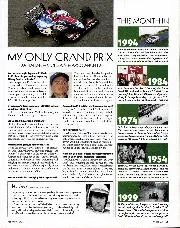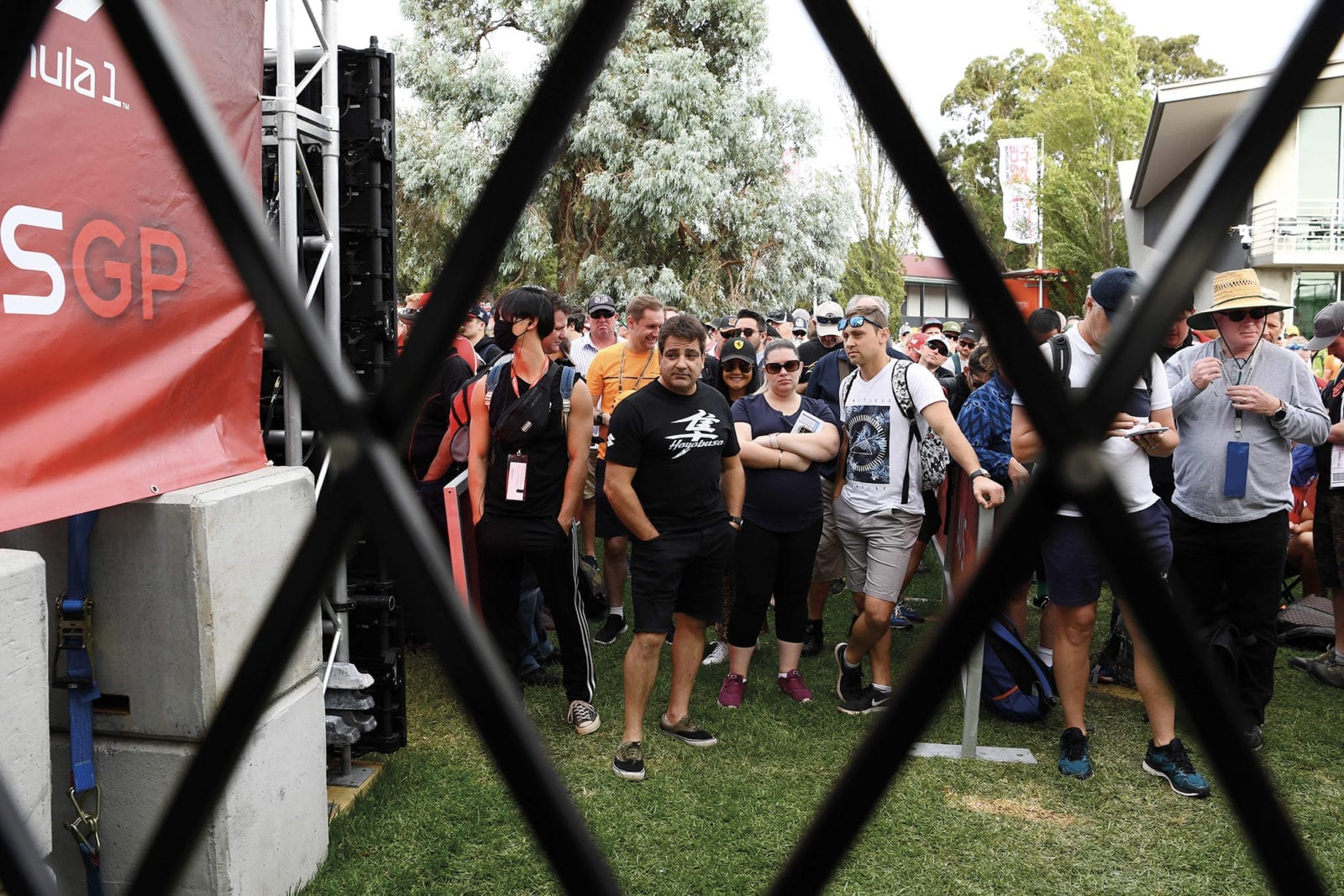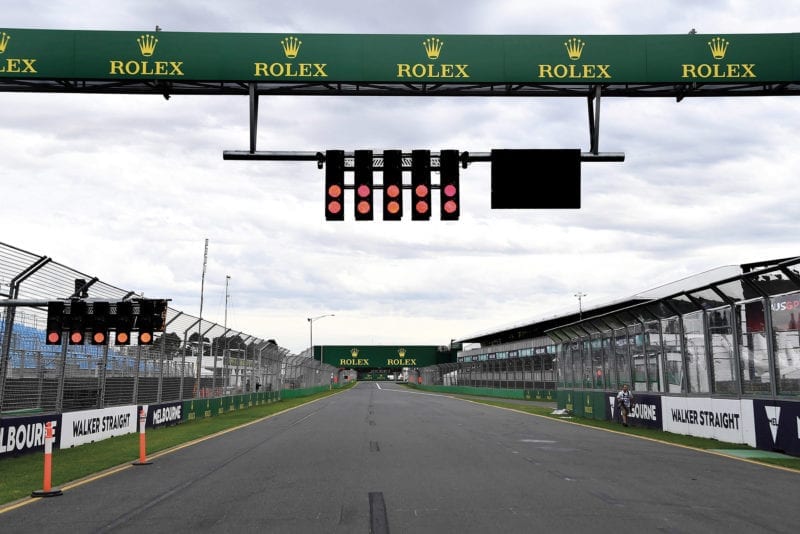
My only Grand Prix
1993 Italian at Monza by Marco Apicella You were racing in Japanese F3000 in 1993. How did you end up replacing Thierry Boutsen at Jordan? I was in Japan and…

Fans turned up as normal, even though the race was doomed
Getty
Formula 1 has always existed in a bubble, sealed from most of the concerns of the wider world. Even as the COVID-19 virus was threatening extensive lockdown, F1 was preparing to travel from Europe to Melbourne for the opening round of 2020. After that, it intended to head straight for Bahrain, though the organisers of that race announced no spectators would be allowed to attend. “Convening a major sporting event, which is open to the public and allows thousands of international travellers and local fans to interact in close proximity, would not be the right thing to do at the present time,” said their statement. F1 could ill-afford to agree, so it said nothing.
It was a particularly troubling time for Ferrari. Fourteen provinces in northern Italy, including that of Modena (in which the Maranello Ferrari factory resides), were put into effective lockdown just as the team’s personnel were preparing to leave. If Ferrari couldn’t take part, the Australian Grand Prix wouldn’t be happening, as Liberty’s Ross Brawn confirmed: “If a team is prevented from entering a country we can’t have a race. Not a Formula 1 World Championship race, anyway, because that would be unfair… Where a team is prevented from going to a race because of a decision of the country then it’s difficult to have a fair competition.”
The last of the team members were leaving on Monday as the travel ban came into effect. With Ferrari taking part, the race was on. That left Ferrari to worry about the ongoing controversy of its secret agreement with the FIA regarding its 2019 power unit – which angered seven rival teams that demanded to know the terms of the agreement and what the FIA’s technical investigation had found. For a few days, this argument almost made things feel normal, the usual competitive niggle and controversy of F1.
“The behaviour of the FIA is the real scandal,” Red Bull’s Helmut Marko told Der Spiegel. “We should actually instruct Christian Horner to sue for $24m in prize money. We lose a double-digit million amount by finishing third instead of second,” he said to Auto Motor und Sport. “Not just because more money is distributed for second place, but because our sponsorship contracts are also performance-related. I assume that the other teams are similar.” This was assuming Ferrari had been operating outside of the fuel flow regulations, the FIA admitted this was not proven. Hence the ‘agreement’ that a Toto Wolff-led group of seven rival teams (all but Ferrari customers Alfa and Haas) objected to in a joint letter which reserved their rights to take legal action.
It read: “We, the undersigned teams, were surprised and shocked by the FIA’s statement of Friday 28 February regarding the conclusion of its investigation into the Scuderia Ferrari Formula 1 Power Unit. An international sporting regulator has the responsibility to act with the highest standards of governance, integrity and transparency. After months of investigations that were undertaken by the FIA only following queries raised by other teams, we strongly object to the FIA reaching a confidential settlement agreement with Ferrari to conclude this matter.

A drawn-out affair: By daybreak Friday, the grand prix was off
Grand Prix Photo
“Therefore, we hereby state publicly our shared commitment to pursue full and proper disclosure in this matter, to ensure that our sport treats all competitors fairly and equally. We do so on behalf of the fans, the participants and the stakeholders of Formula 1. In addition, we reserve our rights to seek legal redress, within the FIA’s due process and before the competent courts.”
Alliances are always temporary in F1. Red Bull and Mercedes, comrades in the Ferrari case, were butting heads elsewhere.
Red Bull threatened to protest Mercedes’ new DAS – the steering column-activated, toe-adjustment system – if it was used in Melbourne. This was in addition to a Red Bull-triggered technical directive on the eve of the race weekend outlawing an extra area of ducting around the Mercedes’ rear wheels, used to control tyre temperatures. There was a protest in the air from Renault, questioning the new Racing Point’s similarity to last year’s Mercedes.
The FIA and Liberty’s Chase Carey, meanwhile, replied to the seven teams to reiterate their position. The teams were not satisfied and drafted a further letter.
Onwards coronavirus crept. China, as the home of the virus, had long since gone into lockdown and postponed its grand prix. But Australia was open and still in the early stages of the virus’ spread. Everything went ahead as normal on Thursday and Lewis Hamilton was not impressed. “I am very, very surprised we are here,” he said in the press conference. “It’s shocking that we’re all sitting in this room. There are so many fans here already today. It seems like the rest of the world is reacting probably a bit late, but already this morning we have seen Trump shutting down the borders from Europe to the United States. The NBA is being suspended, and F1 continues to go on.” He added: “cash is king.”
F1 makes its money from race fees and TV deals. The teams in turn feed off F1’s money. If events were being cancelled or postponed, it would have to be under the stipulation of the country’s government so that the commercial agreements weren’t breached. The Australian Grand Prix Corporation is incorporated into the state of Victoria. So the promoter and local government are intimately related. The government is responsible for the health and wellbeing of its citizens, and its health officials could call a halt to proceedings. But the grand prix is also part of Melbourne’s sporting city credentials. It pays multiple millions of dollars for it.
The virus then arrived. Mechanics from Haas, McLaren and Alfa Romeo were all tested for it on Thursday after feeling unwell.
“Will the first race be Canada in June? That’s up to the virus.”
“If the tests turn up positive, we need to consider what it means for their close contacts,” said Victoria’s chief health officer Brett Sutton, “and if they have a number of close contacts across a number of crews, then those individuals need to be quarantined. If that effectively shuts down the race, then so be it. We’ll make that call.”
The test on the McLaren mechanic came back positive on Thursday evening. The event was doomed. McLaren immediately withdrew. The mechanic and the 14 employees he’d been in close contact with were quarantined for two weeks. Team principal Andreas Seidl stayed behind with them. Ferrari, Renault and Alfa were privately adamant they would take no further part, citing a duty of care to its employees. But if this race was to be cancelled, the organisers weren’t going to do it.
But without those four teams, the grid was now potentially just 12 cars. One less and the FIA would be empowered to call off the event unilaterally. But unless that was advised to them by the teams in a request to cancel, said an FIA spokesman, “the FIA cannot cancel because there are too many commercial agreements that, in cancelling, the liability would come back to us.”
So long as the majority of teams voted to withdraw, they could make that request. It seemed simple. That way, it was force majeure and everyone would be able to make the appropriate claims. Who announced, and in what sequence, had serious commercial implications. But it wasn’t simple. At an emergency Thursday evening team principals’ meeting, not all of them wished to stop. Red Bull, AlphaTauri, Racing Point and Mercedes were initially in favour of continuing, with some paddock ‘lockdown’ precautions. The Victoria health official and the FIA had no objection. But eventually, Toto Wolff changed his position – giving the required majority. By 2am Friday, it was known internally that the event was off.
But the wrangling continued. Who would call it? Not the organisers. Fans were told to come to the gates as normal. Marshals were requested to turn up at their posts. The F1 two-seater Minardi gave circuit rides. But fans turning up at the gates were not allowed in. An announcement from the organisers stated the race would take place without spectators (as a health precaution). But still, no official confirmation that the event was off. In the paddock, teams dismantled their equipment. They weren’t allowed by the organisers to use the pitlane for packing, as it was theoretically in use for support races. This was about ensuring the right chain of announcements to resolve various commercial agreements.Eventually, the teams broke the deadlock by publicising their request to the FIA to cancel.
A joint statement from the FIA, F1 and the organisers quickly followed, part of which read, “The FIA and Formula 1, with the full support of the Australian Grand Prix Corporation (AGPC), have therefore taken the decision that all Formula 1 activity for the Australian Grand Prix is cancelled.” So it was the FIA and F1 which cancelled – and quite specifically not the organisers. A lot of money will depend upon that wording.
Shortly afterwards came confirmation of the Bahrain and Vietnam postponements, followed by the Netherlands, Spain, Monaco and Azerbaijan races. But did that mean the first race of 2020 would be Canada in June? That’s up to the virus. F1 is not in control.